The Stories That Men Tell
- Home
- World War I Articles
- The Stories That Men Tell
When I first started working on my photographic project Fields of Battle, Lands of Peace in 2005 I was given two pieces of advice by the late, great Professor Richard Holmes. The first was to ensure that every picture told a story about the location and secondly to avoid being ‘an over-emotional Celt’. The latter was easy as I myself wanted to get away from the habit of so many books which either presented battlefields in sombre black and white or consisted of a preponderance of cemeteries.
Richard held that simply standing in a cemetery narrating the lives of the men interred there simply bent history out of shape as it ignored the men who had survived and anyhow, except on rare occasions, the cemetery itself did little to enable a better understanding of the events which had led to its sad occupancy. As we all recognise, Richard Holmes was an historian sans-pareil but he always described himself as ‘a military historian who likes to tell stories’.
A simple philosophy but the problem is where to find the stories. It is all very well trawling through official histories and narrating the bare facts but the devil is really in the detail - the personal detail, the detail known to the men on the ground. As a guide one obviously has to have a grasp of the historical facts but having spent time watching other guides and visiting parties it is clear that people relish anything which brings humanity to the forefront of any location. Inevitably cemeteries are about numbers and, as Stalin said, one death is a tragedy but a million dead are only a statistic, and the project required the photographs to reflect the experience of the men involved.
By way of illustration, we all know that on 1 July 1916 there were 60,000 casualties. By the very nature of those losses there are very few personal accounts from the front line but one which stands out for me is that of Edward Liveing, serving with the 12th. London Regiment at Gommecourt, whose account, Attack on the Somme, combines revealing detail and subtle comment as he describes how
I started off at the prearranged walk. A continuous hissing noise all around one ... signified that the Germans machine gunners had become aware of our presence ... in front the ground was pitted by innumerable shell-holes... Here and there a few bodies lay about ... one man after another fell down in a seemingly natural manner and the wave melted away. ... I came up to the German wire ... and advanced to a gap in the German wire. There was a pile of our wounded here ... Suddenly I cursed. I had been scalded in the right hip ... I dropped forward full length on the ground.
Liveing started to crawl back towards his own lines.
Little holes opened in the ground on either side of me and I understood that I was under machine-gun fire. ... I fell down into a sunken road with several other wounded ... the Germans had a machine gun on that road and only a few of us got across.
Finally he reached Hebuterne where
.. the RAMC were bandaging the ever increasing flow of wounded. Amongst them a captive German in green uniform with a Red Cross round his sleeve was hard at work. Everything seemed so different from the deadly strife a thousand yards away. There, foe was inflicting wounds to foe; here were our men attending to the German wounded and the Germans attending to ours ... Here were both sides united in a common attempt to repair the ravages of war. Humanity had at last asserted itself.
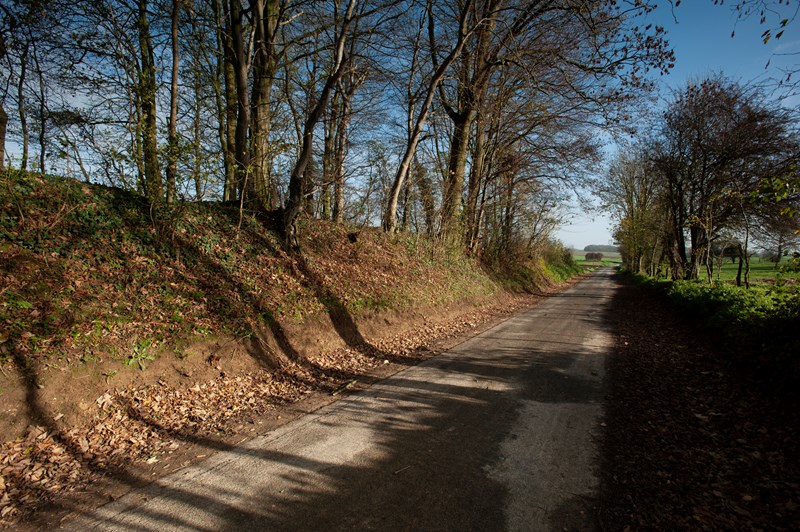
Above: The sunken road at Gommecourt which Liveing managed to cross despite the enfilading machine-gun fire from Rossignol Wood which is visible down the road on the horizon.
From the darkness on all sides came the groans and wails of wounded men; faint, long sobbing moans of agony, and despairing shrieks. It was too horribly obvious that dozens of men with serious wounds must have crawled for safety into new shell-holes, and now the water was rising about them and, powerless to move, they were slowly drowning...and we could do nothing to help them....
At about 9 am I dragged myself wearily out to take a muster parade on which my worst fears were realized. It was a terrible list. … Feeling sick and lonely I returned to my tent to write out my casualty report; but instead I sat on the floor and drank whisky after whisky as I gazed into a black and empty future.

Above: The site of ‘Springfield’ bunker where Vaughan spent the night listening to the sound of the wounded drowning in the shell-holes.
Sometimes a memoir provides a description of the ground which renders a guide as redundant. Devil in the Drum by John Lucy’s has an inch perfect description of the ground over which the Royal Irish Rifles fought on the Aisne in 1914.
Another company took our place in the front and we went underground into conveniently situated large caves, a little distance in rear of the line. The medical officer had opened up his dressing station at the mouth of one cave and was already busy attending the wounded and the dead. He went along the line of those who had been hit and his preliminary test for life in each lying figure seemed to be a pinch under the jaw.
We were ordered to fall in outside the caves and out we went shying a bit at the sight of blood-dripping stretchers propped against the wall of the cave mouth ... a hollow in the ground about 10 yards from the caves was filled with bandaged wounded .... they did not seem very distressed... a rising tearing noise like that of an approaching train heralded the arrival of a heavy shell ... we crouched down where we were ... we closed our teeth to the shattering burst, which seemed right on top of us ... I raised my head to see that the shell had exploded precisely over the hollow and killed every one of the wounded.
We fixed our bayonets, as the enemy were close, our task being to engage any enemy on our front...My brother’s platoon suddenly got the order, unheard by me, and up went the men on the open grassland. Denis went ahead … He … presented a good picture of the young leader going into battle ... I shouted to him: “Take care of yourself”. … My brother steadied a moment in a stride which was beginning to break into a steady run forward and looking back over his shoulder winked re-assuringly at me. The beggar could wink.
Forward he went, and out of my sight for ever.
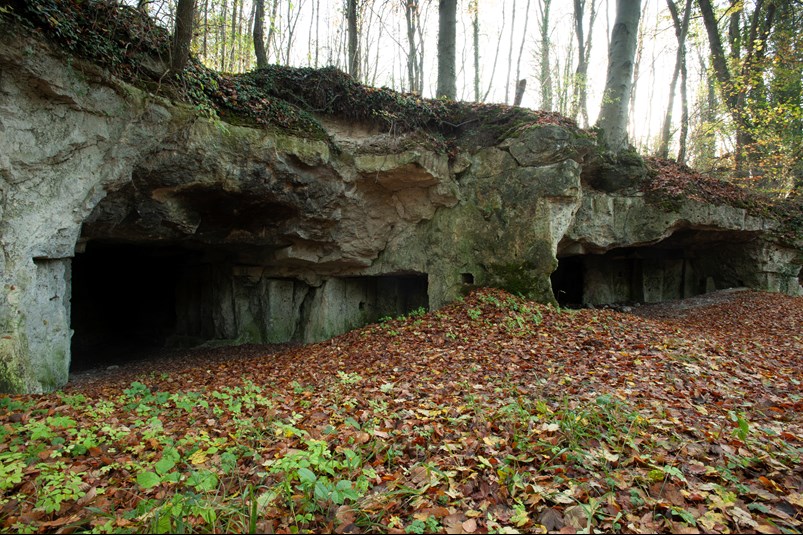
Above: The caves where a German shell killed the wounded who were lying in the foreground.
Not far away is the remarkable Chapelle de Pére Doncoeur, created by the French poilus in an underground limestone quarry. An anonymous soldier described it thus
.. a sergeant in my company, Theo Potel, is an amateur painter and at the end of the cave we have made, in a big oval niche, a cross with Christ around which he has painted the light of the rising sun in a superb red. … On the two sides of the chapel Potel has painted flowers for us which has a beautiful effect. ... for light there are two small candlesticks each with four candles on the altar: two other big ones with six candles stand on either side of the altar. For decoration on either side there are two splendid fir trees.
Now comes the hour. The lights are glowing and the singers are near the altar ... A huge crowd of men take their place in the corridor. Everyone gathers their thoughts and the mass begins.
The moment of the elevation comes: the piquet are carrying arms as the bugles have just sounded the call to arms. ... and then to finish the Mass we sing three verses of the Marseillaise. At that moment, it was so beautiful it brought tears to one’s eyes ...
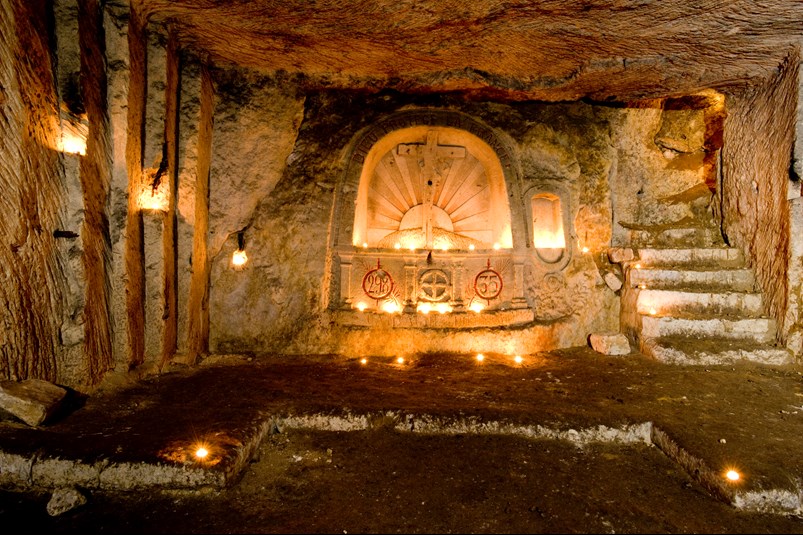
Above: Richard Holmes told me that whenever he visited this cave, he was ‘deafened by the sound of silent voices singing La Marseillaise.’
Sometimes, quite literally, a sudden burst of light on the landscape brings the writer’s words to life. On 7 June 1917 Phillip Gibbs, the war correspondent for the Daily Telegraph, witnessed the awesome series of exploding mines along the Messines ridge and wrote that
“great leaping streams of orange flame shot upwards, each a huge volcano...along the front of attack followed by terrific explosions and dense masses of smoke and dust which stood like pillars towering into the sky, all illuminated by the fires below”.
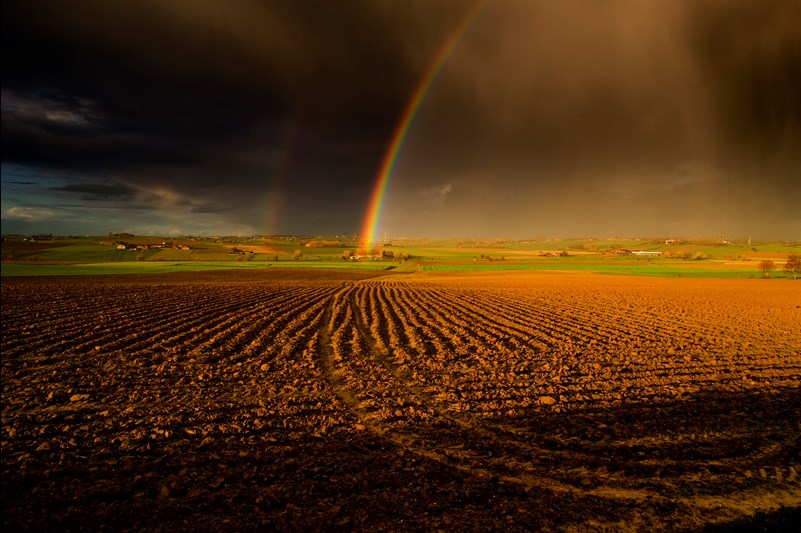
Above: Rainbow over the Messines Ridge
J R R Tolkien derived much imagery from his time serving with the Lancashire Fusiliers in the Ancre Valley and in The Two Towers he describes how
…cold clammy winter still held sway in this forsaken country. The only green was the scum of livid weed on the dark greasy surfaces of the sullen waters. Dead grasses and rotting reeds loomed up in the mists … Dead grasses and rotting reeds loomed up in the mists....Sam tripped...for a moment the water below him looked like some window, glazed with grimy glass through which he was peering ...”There are dead things, dead faces in the water,” he said with horror. “Dead Faces!
at which point Gollum, their guide, explains
There was great battle long ago … the Marshes have grown since then, swallowed up the graves … you cannot reach them, you cannot touch them. …All dead.
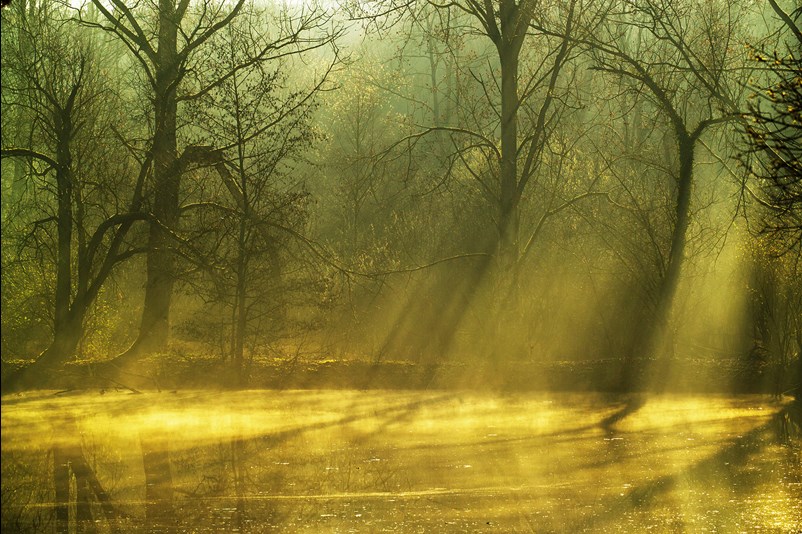
Above: The marshes of the Ancre
That most vivid of writers, Ernst Junger, also recounts an encounter with the dead in Storm of Steel, surely one of the defining books of the conflict. Junger’s diaries reveal in great detail his exact position so in April 1915 one can place him to within fifty meters in woods near Les Éparges when
Through a stuttering swathe of machine-gun fire, we plunged back into our communication trench, and moved to a position on the edge of the wood, previously held by the French. A sweetish smell and a bundle hanging in the wire caught my attention. In the rising mist, I leaped out of the trench and found a shrunken French corpse... all around were dozens more, rotted, dried, stiffened to mummies, frozen in an eerie dance of death.
He then describes how he gets shot and he
… ran towards the trench we had come from...it was choked with seriously wounded and dying men... this was the home of the great god Pain, and for the first time I looked through a devilish chink int the depths of his realm. … I lost my head completely. Ruthlessly I barged past everyone on my path … Like a bolting horse, I rushed through the dense undergrowth, across paths and clearings, till I collapsed in a copse by the Grande Tranchee”.
Whatever one may say about Junger, - and I am aware that many people dislike his blunt descriptions of killing his enemies, - but that surely is what soldier are supposed to do in the course of their ‘work’ - I think this confession of his panic, even cowardice, endows his work with a total honesty that one has to respect.
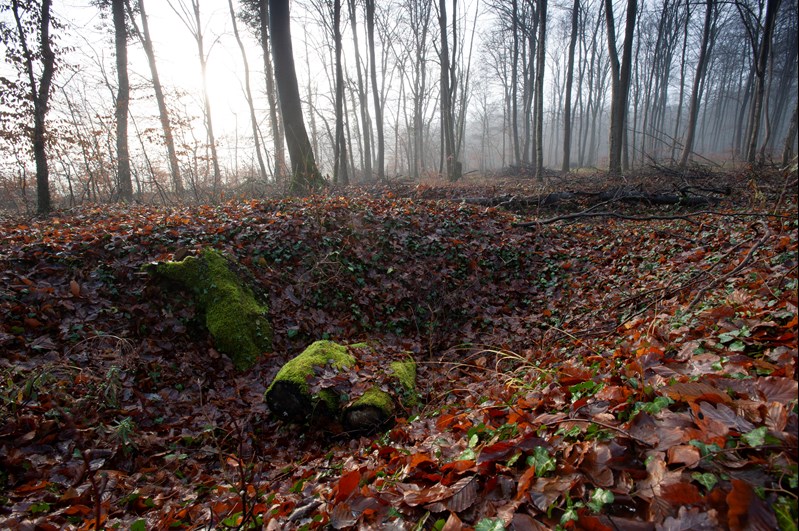
Above: The French trenches where Junger found himself surrounded by French dead
Sometimes one has the situation where a simple comment by a writer reveals a totally new aspect of the war. Such is the case with an account by Hans Schröder, a German pilot and infantry officer who described in An Airman Remembers how, stationed on the Hartmannswillerkopf:
My positions there extend from the Sachesnfad, where my dug-out lies, and down through the so-called “Heavenly Ladders” to the lower Rehfelsen. There the opposing trenches are only a few yards away - one can talk to the French from them. … our lines are protected by the electric current applied from the Gebweiler power station … the night before last the men connected up the French wire with our own … in the morning they saw an enemy patrol hanging on their own wire.
Later he describes a French attack when:
We poured a continuous stream into the thick blue-grey masses - then we saw the foremost of them caught by the current of our wire entanglements. It was a ghastly sight!
All of this makes it quite clear that in some sectors, where sufficient power was available, the Germans used electrified wiring. Some of that wiring is still intact and is the only wiring that I have seen on the Western Front whose original geometric pattern is still clearly visible.
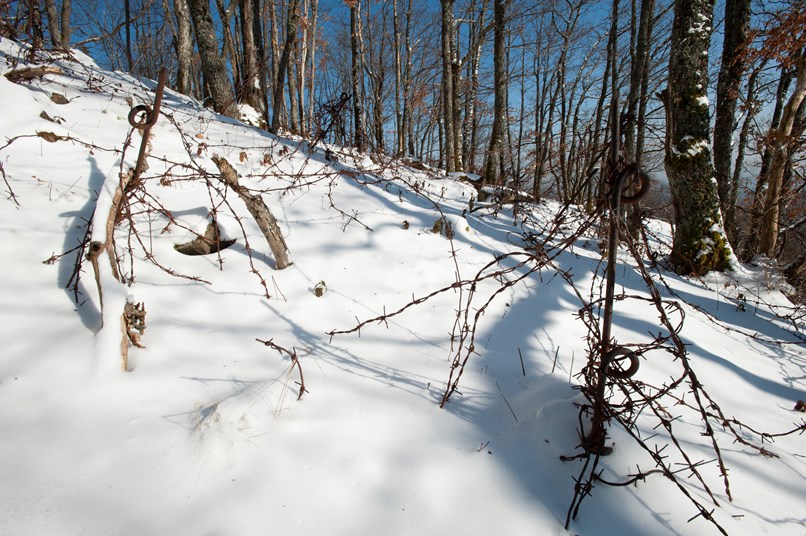
Above: German barbed wire at Lower Rehfelsen
Many French descriptions are typified by their rather dramatic prose style but Carnets d’un fantassin by Charles Delvert must surely be one of the best WWI memoirs as he describes the struggle for Verdun in simple, powerful words.
June 1 -
During the evening the R1 redoubt was attacked but two of our machine guns swept the slopes and cooled the enemy’s enthusiasm. It is a sad sight in our trenches, the ground is spattered everywhere with blood: the light of the setting sun shows the stiffening corpses like some bloody scene in a painting. Everywhere there are nameless fragments.
June 2 -
2000 hrs ...the Germans jumped out of their trenches. Here all the world is mad. I had distributed all the grenades because at such close quarters rifles are useless. We shortened the fuses and let them have it. They replied with rifle grenades but they passed overhead. Surprised by our reception, they retreated…
2200 A man arrived with 5 flasks of water, one of them empty for all the company. Each flask holds 2 litres so there was just 8 ltrs for 71 men. The adjutant made a fair distribution of the water but it seemed to smell of the dead.
June 5 -
… relieved with just 38 men left. Alas what sad sentinels we are leaving behind. There they are, lined up on the parapet, stiff and bloody but still seeming to guard this land even in their death.
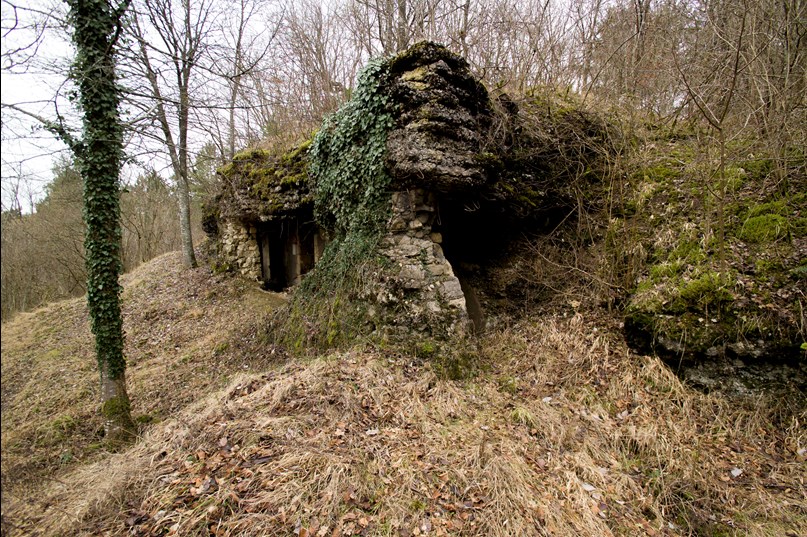
Above: R1 Redoubt near Fort Vaux where Delvert and his men were stationed
Verdun was its own peculiar war within a war and today the ground at Thiaumont is perhaps the most tortured ‘battlescape’ of the entire Western Front. Raymond Jubert, an officer in the 151st RI reflected on his time there in his book Verdun 1916, and simply wrote that
The infantryman has no function except to get himself crushed, he dies without glory … at the bottom of a hole, far away from any witness’.
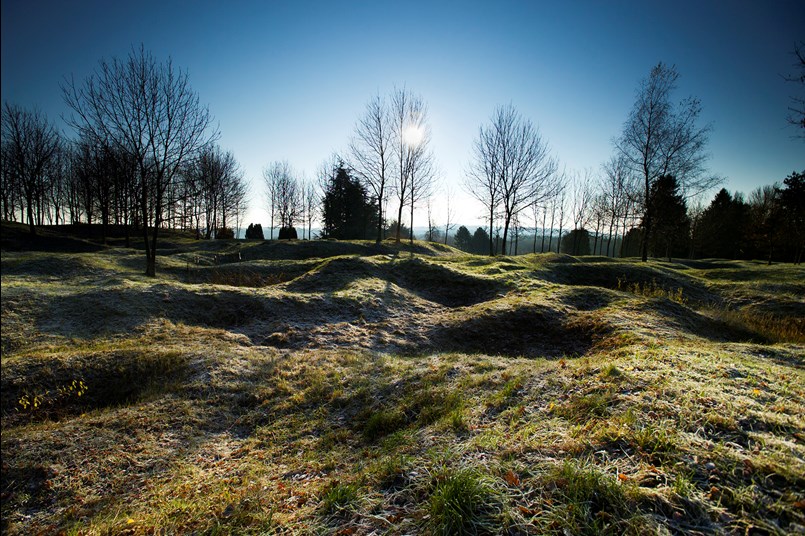
Above: The shell-pocked ground at Thiaumont shows the true face of a WWI battlefield
French battlefields are a rewarding places to visit as often their state of preservation gives an immediate impression of the nature of trench warfare and none is more evocative than Le Linge, a rocky ridge in the Vosges where the trenches were a mere 7 metres apart. Henri Belmont gives us a flavour of this extraordinary place in his diary for August 1915
It is near the summit of this famous Lingekopf, where we are, that the 11th Battalion has been since August 5, in close contact with the Boches, who, after having been driven from it have returned to the charge, without much success however. The crest itself is occupied neither by them nor by us. The rival trenches are face to face at a short distance on the rounded brow which forms the summit. Between these two lines the ground has become a charnel-house. The bodies of infantrymen who have fallen in the course of successive attacks and the bodies of Germans killed by our guns in recent counter-attacks lie stretched in all positions amidst twisted barbed wire and felled pine trees. At certain times the air is tainted with an abominable smell. My company is at the extremity of this crest on a steep and rocky slope, which dips down rapidly. There a sort of wall has been built—a rampart of stones and bags of earth. Loop-holes have been made in it, and we have succeeded in stretching a few strands of barbed wire in front. Behind this wall the infantry hold themselves ready day and night to receive and repulse attacks which the Germans may attempt against us.
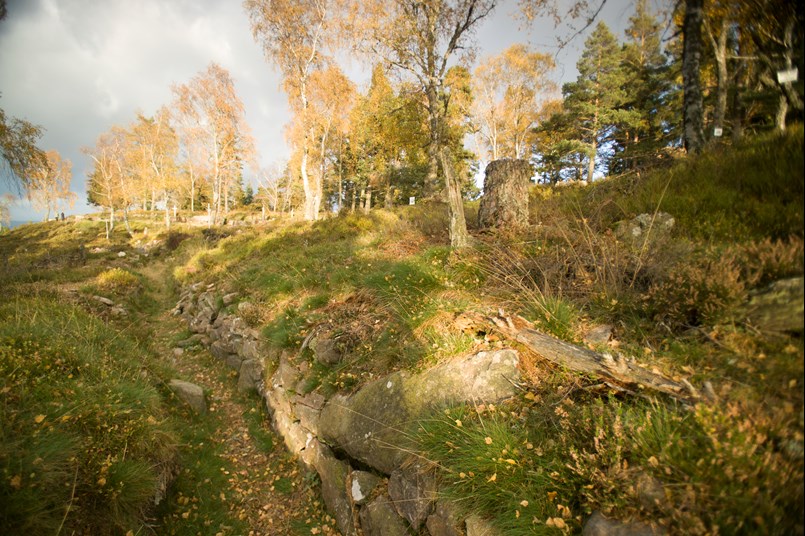
Above: The French front line trench at Le Linge with the German front line atop the slope on the right of the picture
The plethora of well written American accounts belies the seeming national indifference to their part in the conflict. Blue Ridge Memoir is a sadly forgotten narrative by Edward Lukens: beautifully written with perceptive comment and a great eye for detail it offers a superb vignette of the AEF campaign in the Argonne.
As our first drive had shown us, the thick woods which checker-board the hills of Cunel .... made far more difficult going than the bald, shell-pocked hills around Verdun. ... the proportion of forest to clearing was just about enough so that all the clearings were covered by the field of fir from unseen guns in the woods, while the woods were filled with snipers and accurately ranged for artillery.
The fighting around this region was ... not handled as well from above as was the initial state of the drive.... frequent changes of orders, uncertainty as what we were supposed to be doing, incorrect artillery firing and almost total lack of aviation were annoying features ... in spite of everything we gained ground ... but let any critic look at the rows of wooded hills ... the old Boche MG and artillery positions ... and say whether the war could have been won in 1918 if they had not been taken. ... our staff officers were inexperienced in that kind of work ... but how in the world could we have had an experienced army without waiting for the next spring and incurring casualties all winter
A kilometer of open field lay in front of us, the next ridge being crowned by the Bois des Ogons. We advanced at a steady walk... Boche plains circled over our heads ... shells tore holes in the earth ... time after time a big one would come tearing through the air , a dozen men nearest it would drop, a cloud of earth and smoke would appear and one would wonder whether of any of them had escaped. In an instant one would get up and then another ... sometimes one or two would lie still.
We reached the edge of the Bois des Ogons ... the planes had seen us ... a perfect hail of shells landed among the trees ahead of us... we jumped up out of our scanty protection and plunged into the forest ... going single file at five pace intervals so that a direct hit on one man would perhaps spare the man next to them.
I was leading the way with my runner Pvt. Symington about five paces behind me when a shell burst in the soft soil between Symington and me ... only the interval and the softness of the soil saved us .... it was ten minutes before my ears stopped ringing.
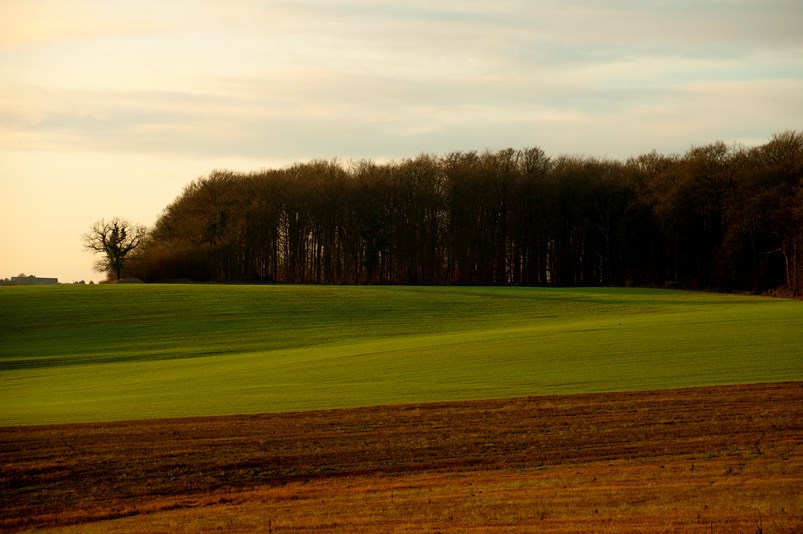
Above: The attack described by Lukens crossed this field and entered the Bois des Ogons in the distance.
Another detailed comes from an American gunner who wrote a letter to his fiancée from Verdun describing how
There is an old battery of 155 long guns across the road … I have a very large arched room which contains the battery kitchen. On one side I have a small room with a lot of maps and firing tables and other necessary Battery commander junk. On the other I have a sleeping apartment … I have a telephone right at my bedside so… I can be immediately informed. I have all the comforts of home except that I’ll have a habit sleeping underground that I’ll have to go to the cellar to sleep when I get home.
The arched chamber he describes is still visible as the Batterie de l’Hôpital at Verdun and the writer would become known to the world as President Harry S. Truman.
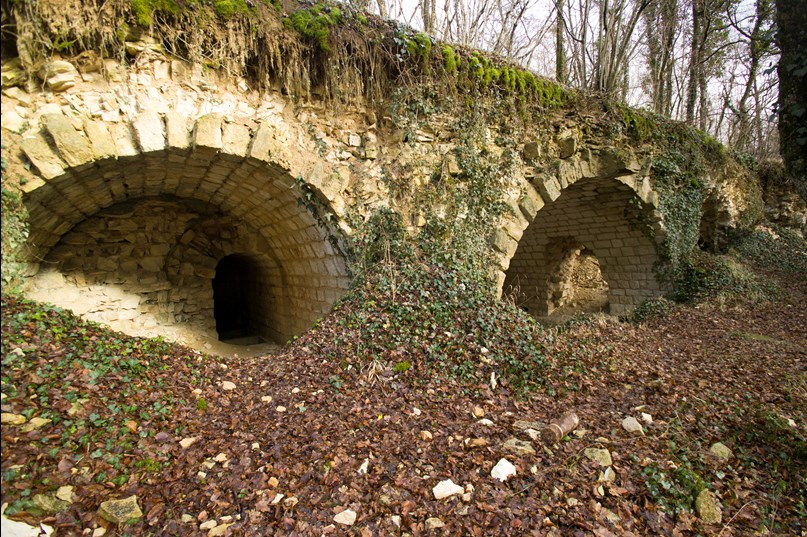
Above: The arched chambers of the Batterie de l’Hôpital at Verdun where Harry S Truman wrote his letter.
Most people have heard the story of Capt Billy Neville and his footballs on 1 July 1916. In fact he almost certainly was inspired by a previous action on 25 September 1915 when the London Irish Rifles attacked at Loos. Patrick MacGill, who would later find fame in America as the ‘navvy poet’, was serving as a stretcher bearers and he described how he
… peered over the top. The air blazed with star-shells, and Loos in front stood out like a splendid dawn. A row of impassive faces, sleep-heavy they looked, lined our parapet; bayonets, silver-spired, stood up over the sandbags; the dark bays, the recessed dug-outs with their khaki-clad occupants dimly defined in the light of little candles took on fantastic shapes. I could hear faint, indescribable rustlings as the winds loitered across the levels in front; a light shrapnel shell burst, and its smoke quivered in the radiant light of the star-shells. Showers and sparks fell from high up and died away as they fell. Like lives of men, I thought, and again that feeling of proximity to the enemy surged through me.
The moment had come when it was unwise to think. ... The air was vicious. with bullets; a million invisible birds flicked their wings very close to my face. Ahead the clouds of smoke, sluggish low-lying fog, and fumes of bursting shells, … and formed a striking background for the soldiers who were marching up a low slope towards the enemy's parapet. There was no haste in the forward move, every step was taken with regimental precision … at a point on the right there was some confusion and a little irregularity. Were the men wavering? No fear! The boys on the right were dribbling the elusive football towards the German trench.
By the German barbed wire entanglements were the shambles of war. … The Irish were now met with harrying rifle fire, deadly petrol bombs and hand grenades. Here I came across dead, dying and sorely wounded; lives maimed and finished … Here, too, I saw, bullet-riddled, against one of the spider webs known as chevaux de frise, a limp lump of pliable leather, the football which the boys had kicked across the field.
I had been at work all the morning dressing the wounded, but there were so many. I was a mere child emptying the sea with a tablespoon.
Today the bullet scarred London Irish ‘Loos Football’ must be one of the most evocative items from the conflict so I was amazed when my presumptuous request to take the football back to its ‘home ground’ was granted. Museum curators blanch when I tell them how I took an irreplaceable relic and placed it in a muddy field but then, as the LIR curator said, ‘what better place for it to tell its story?’
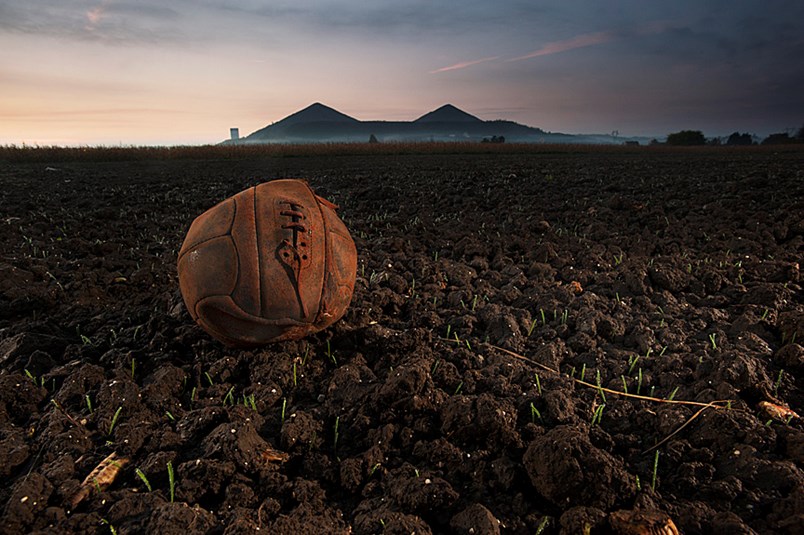
Above: The London Irish Rifles ‘Loos Football’ on it’s ‘home ground’
Mike St Maur Sheil
Mike St Maur Sheil MA, FRGS is a photographer who created the series of multi-national exhibitions entitled Fields of Battle, Lands of Peace and who now regularly guides for Battlehonours Tours.





